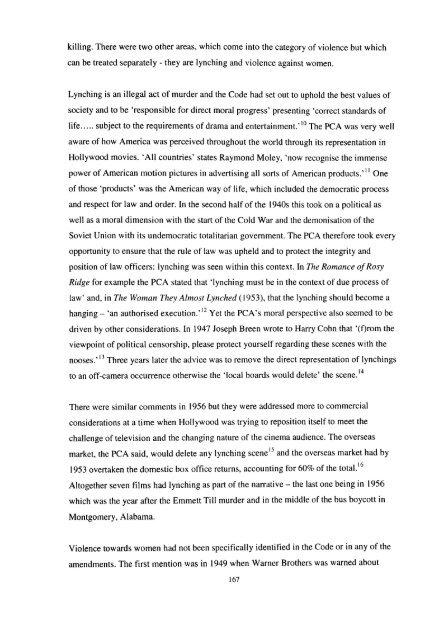Download (3483kB) - Greenwich Academic Literature Archive ...
Download (3483kB) - Greenwich Academic Literature Archive ...
Download (3483kB) - Greenwich Academic Literature Archive ...
- No tags were found...
Create successful ePaper yourself
Turn your PDF publications into a flip-book with our unique Google optimized e-Paper software.
killing. There were two other areas, which come into the category of violence but whichcan be treated separately - they are lynching and violence against women.Lynching is an illegal act of murder and the Code had set out to uphold the best values ofsociety and to be 'responsible for direct moral progress' presenting 'correct standards oflife..... subject to the requirements of drama and entertainment.' 10 The PCA was very wellaware of how America was perceived throughout the world through its representation inHollywood movies. 'All countries' states Raymond Moley, 'now recognise the immensepower of American motion pictures in advertising all sorts of American products.' 11 Oneof those 'products' was the American way of life, which included the democratic processand respect for law and order. In the second half of the 1940s this took on a political aswell as a moral dimension with the start of the Cold War and the demonisation of theSoviet Union with its undemocratic totalitarian government. The PCA therefore took everyopportunity to ensure that the rule of law was upheld and to protect the integrity andposition of law officers: lynching was seen within this context. In The Romance of RosyRidge for example the PCA stated that 'lynching must be in the context of due process oflaw' and, in The Woman They Almost Lynched (1953), that the lynching should become ahanging - 'an authorised execution.' 12 Yet the PCA's moral perspective also seemed to bedriven by other considerations. In 1947 Joseph Breen wrote to Harry Cohn that '(f)rom theviewpoint of political censorship, please protect yourself regarding these scenes with thenooses.' 13 Three years later the advice was to remove the direct representation of lynchingsto an off-camera occurrence otherwise the 'local boards would delete' the scene. 14There were similar comments in 1956 but they were addressed more to commercialconsiderations at a time when Hollywood was trying to reposition itself to meet thechallenge of television and the changing nature of the cinema audience. The overseasmarket, the PCA said, would delete any lynching scene 15 and the overseas market had by1953 overtaken the domestic box office returns, accounting for 60% of the total. 16Altogether seven films had lynching as part of the narrative - the last one being in 1956which was the year after the Emmett Till murder and in the middle of the bus boycott inMontgomery, Alabama.Violence towards women had not been specifically identified in the Code or in any of theamendments. The first mention was in 1949 when Warner Brothers was warned about167
















